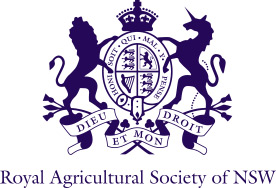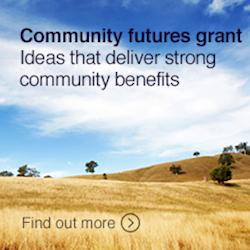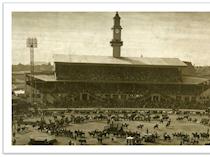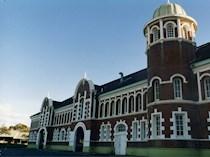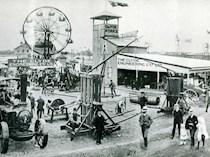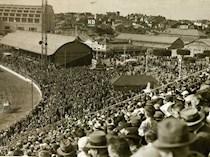Explore our history
In many ways, the history of the Royal Agricultural Society of NSW echoes that of the nation’s history more broadly. The social, political, economic and climatic conditions of each passing era have all left their marks on the RAS and influenced its activities. So when you explore our story, there’s a good chance you’ll find something that throws a light on Australia’s many stories too. From its earliest beginnings at Parramatta to the present day, the RAS has endured by responding to – and encouraging – change.
1882-1914
Building a ground
As the 1880s kicked over, the Agricultural Society’s finances tightened and the lease on its first city showground, Prince Alfred Park, became unaffordable. A new, long-term home was needed where permanent buildings and dedicated infrastructure could be developed. After an extensive search, ten hectares of otherwise ‘useless’ land were found, east of the Cricket Ground, at Moore Park. Tenure was secured from the City Council for an annual rent of ten pounds.
It was a scramble to put on the first Show in 1882, but the transformation of the ‘unprofitable sandy patch’ was widely admired. Sturdy animal sheds and pavilions were constructed; and a spacious oval was laid out, surrounded by a trotting track. Inside the arena were two judging rings and four fences for horse-jumping events. The oval was an important new asset, generating income from sporting clubs and other organisations that hired it during the year – a revenue model that continues today.
Consolidation
In 1891 the Society assumed its present name when Queen Victoria granted permission to use the prefix Royal.
Throughout the late 1890s and the post-Federation years, the Royal Agricultural Society of NSW cemented its position, introducing new competitions and expanding facilities. Increasingly, mining and secondary industries, technical innovators and commercial operators were encouraged to exhibit. As well, the Society showed renewed interest in education, partnering with the Government’s recently formed Department of Agriculture to put on lectures and displays.
'The growth of the premises is in its way one of the most remarkable developments of the time. It is not so many years ago since the society was making shift in a collection of unaesthetic shanties. Today it exercises proprietorship over a veritable township – an area of named streets and creditable buildings, and buildings too, which are becoming more numerous and imposing every year.'
- The Sydney Morning Herald, 15 April 1910
Annual holiday
During this period, Easter settled as the preferred time to hold the Show. Each year a festival atmosphere gripped the city as country and interstate visitors booked out hotels or bunked-in with family and friends. While in town, people went shopping and did important business, also going to the many sporting, social and cultural events held at Showtime.
By this time, the Easter Show had become a major driver of the State’s economy.
1914-1945
Two World Wars and in between
Despite military occupation of the ground throughout WWI, the Show continued to be held. But in 1919 returning troops brought back the deadly Spanish influenza, prompting the Show’s cancellation that year as a public health measure. Temporary hospital wards and a morgue were set up on the Showground. When the crisis was over the RAS quickly regrouped, however, working closely with Government to reset the State’s post-war agricultural agenda.
In the 1920s another parcel of land was added to the Showground, which had grown in area over the years. An ambitious building program began, and by the end of the 1930s all the iconic buildings of Moore Park were in situ. When the worst of the Great Depression was over attendances grew, and in 1938 an astonishing one million visitors poured through the gates for the first time.
WWII broke out and the army took over the Showground again, vacating each Showtime until 1941. Ultimately, military needs took priority and the Show closed until the end of the war.
1947-1997
Post-war modernity
The first Show after the war in 1947 was another blockbuster. For the next 50 years attendances passed the million-mark on all but seven occasions as Australia and the RAS enjoyed a post-war boom.
New Australians were welcomed at the Show during this period, and the contribution of women in agriculture was recognised with the election of women to the RAS Council.
As the decades flipped over, the Show embraced whatever was modern: appliances, technology, fashion, space-age entertainments, all while preserving its much-loved traditions.
Search our Museum
Something to add?
Do you have an artifact or story from
RAS NSW history to add?
